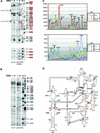Monitoring intermediate folding states of the td group I intron in vivo
- PMID: 12356744
- PMCID: PMC129027
- DOI: 10.1093/emboj/cdf504
Monitoring intermediate folding states of the td group I intron in vivo
Abstract
Group I introns consist of two major structural domains, the P4-P6 and P3-P9 domains, which assemble through interactions with peripheral extensions to fold into an active ribozyme. To assess group I intron folding in vivo, we probed the structure of td wild-type and mutant introns using dimethyl sulfate. The results suggest that the majority of the intron population is in the native state in accordance with the current structural model, which was refined to include two novel tertiary contacts. The importance of the loop E motif in the P7.1-P7.2 extension in assisting ribozyme folding was deduced from modeling and mutational analyses. Destabilization of stem P6 results in a deficiency in tertiary structure formation in both major domains, while weakening of stem P7 only interferes with folding of the P3-P9 domain. The different impact of mutations on the tertiary structure suggests that they interfere with folding at different stages. These results provide a first insight into the structure of folding intermediates and suggest a putative order of events in a hierarchical folding pathway in vivo.
Figures





Similar articles
-
A tyrosyl-tRNA synthetase suppresses structural defects in the two major helical domains of the group I intron catalytic core.J Mol Biol. 1996 Sep 20;262(2):87-104. doi: 10.1006/jmbi.1996.0501. J Mol Biol. 1996. PMID: 8831782
-
The P4-P6 domain directs higher order folding of the Tetrahymena ribozyme core.Biochemistry. 1997 Mar 18;36(11):3159-69. doi: 10.1021/bi962428+. Biochemistry. 1997. PMID: 9115992
-
A tyrosyl-tRNA synthetase protein induces tertiary folding of the group I intron catalytic core.J Mol Biol. 1996 Apr 5;257(3):512-31. doi: 10.1006/jmbi.1996.0182. J Mol Biol. 1996. PMID: 8648621
-
Folding of the td pre-RNA with the help of the RNA chaperone StpA.Biochem Soc Trans. 2002 Nov;30(Pt 6):1175-80. doi: 10.1042/bst0301175. Biochem Soc Trans. 2002. PMID: 12440999 Review.
-
Group II introns and expression of conjugative transfer functions in lactic acid bacteria.Antonie Van Leeuwenhoek. 1999 Jul-Nov;76(1-4):77-88. Antonie Van Leeuwenhoek. 1999. PMID: 10532373 Review.
Cited by
-
Dissecting RNA chaperone activity.RNA. 2007 Dec;13(12):2053-60. doi: 10.1261/rna.671807. Epub 2007 Sep 27. RNA. 2007. PMID: 17901153 Free PMC article.
-
Group II intron folding under near-physiological conditions: collapsing to the near-native state.J Mol Biol. 2007 Mar 2;366(4):1099-114. doi: 10.1016/j.jmb.2006.12.003. Epub 2006 Dec 6. J Mol Biol. 2007. PMID: 17196976 Free PMC article.
-
The Neurospora crassa CYT-18 protein C-terminal RNA-binding domain helps stabilize interdomain tertiary interactions in group I introns.RNA. 2004 Apr;10(4):634-44. doi: 10.1261/rna.5212604. RNA. 2004. PMID: 15037773 Free PMC article.
-
DEAD-box protein facilitated RNA folding in vivo.RNA Biol. 2010 Nov-Dec;7(6):803-11. doi: 10.4161/rna.7.6.13484. Epub 2010 Nov 1. RNA Biol. 2010. PMID: 21045551 Free PMC article.
-
Molecular modelling of the GIR1 branching ribozyme gives new insight into evolution of structurally related ribozymes.EMBO J. 2008 Feb 20;27(4):667-78. doi: 10.1038/emboj.2008.4. Epub 2008 Jan 24. EMBO J. 2008. PMID: 18219270 Free PMC article.
References
-
- Ban N., Nissen,P., Hansen,J., Moore,P.B. and Steitz,T.A. (2000) The complete atomic structure of the large ribosomal subunit at 2.4 Å resolution. Science, 289, 905–920. - PubMed
-
- Belfort M., Chandry,P.S. and Pedersen-Lane,J. (1987) Genetic delineation of functional components of the group I intron in the phage T4 td gene. Cold Spring Harb. Symp. Quant. Biol., 52, 181–192. - PubMed
-
- Caprara M.G., Lehnert,V., Lambowitz,A.M. and Westhof,E. (1996a) A tyrosyl-tRNA synthetase recognizes a conserved tRNA-like structural motif in the group I intron catalytic core. Cell, 87, 1135–1145. - PubMed
Publication types
MeSH terms
Substances
LinkOut - more resources
Full Text Sources
Research Materials

